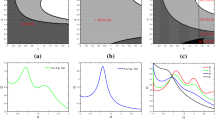Abstract
Coupled resonator is one of the fundamental physical systems, which has always been modeled by integer-order calculus or composed of integer-order components. To achieve wider operating area of low power consumption, the energy distribution of coupled resonator is often expected to be robust. However, the energy distribution is susceptible to the interference of resonator parameters shifting in real world, such as coupling strength and resonator frequency. Traditionally, the anti-interference ability of integer-order coupled resonator can be acquired by using externally and additionally complicated control. Here, we report an alternative fractional-order autonomous coupled resonator, in which the anti-interference ability can inherently arise through its fractional-order nature. By using the equivalent coupling circuit of fractional-order autonomous coupled resonator, its energy characteristics are analyzed. Moreover, we theoretically find and experimentally prove that the energy distribution of the fractional-order coupled resonator could be locked by the order of fractional-order element. Our work could help coupled resonator acquire unprecedented anti-interference ability.







Similar content being viewed by others
Data availability
The data that supports the findings of this study are available within the article.
References
Ma, K., Zhang, Y., Su, H., Yu, C., Wang, J.: Tunable coupled-resonator induced transparency based on asymmetrical self-interference ring resonators. J. Lightwave Technol. 37, 3728–3733 (2019)
Kurs, A., Karalis, A., Moffatt, R., et al.: Wireless power transfer via strongly coupled magnetic. Science 317, 83–86 (2007)
Zergoune, Z., Kacem, N., Bouhaddi, N.: On the energy localization in weakly coupled oscillators for electromagnetic vibration energy harvesting. Smart Mater. Struct. 28, 1–9 (2019)
Liu, G., Peng, Y., Liu, M., Zou, X. and Cheng, J.: Broadband acoustic energy harvesting metasurface with coupled Helmholtz Resonators. Appl. Phys. Lett. 113, 153503 (2018)
Zhang, D., Cao, Y., Qi, Q., Tu, Y.: The energy cost and optimal design for synchronization of coupled molecular oscillators. Nat. Phys. 16, 95–100 (2020)
Zanette, D: Energy exchange between coupled mechanical oscillators: linear regimes. J. Phys. Commun. 2, 095015 (2018)
Sosa, R., Zanette, H.: Energy exchange in globally coupled mechanical phase oscillators. Phys. Rev. E. 102, 012208 (2020)
Tsay, A., Van, V.: Strongly-coupled microring resonators and the effect of nonadjacent resonator coupling. 23rd annual meeting of the IEEE photonics society (2010)
Jiao, X., Yu, H., Yu, M., Xue, C. and Ren, Y.: Coupled resonator-induced transparency on a three-ring resonator. Chin. Phys. B. 27, 074212 (2018)
Lee, W., Jang, H.S., Oh, K.S., Yu, J.W.: Close proximity effects of metallic environments on the antiparallel resonant coil for near-field powering. IEEE Trans. Antennas Propag. 61, 3400–3403 (2013)
Marquez, S. et al.: Asymmetrically coupled resonators for mass sensing. Appl. Phys. Lett. 111, 113101 (2017).
Zhu., Q. et al.: Automated wavelength alignment in a 4 × 4 silicon thermo-optic switch based on dual-ring resonators. IEEE Photon. J. 10, 6600311 (2018)
Zhen, Z., Li, S.F.: Analysis of a silicon dual-coupled-ring resonator modulator based on push-pull coupling tunings. IEEE Photon. J. 10, 6600112 (2018)
Gati, E., Kampitsis, G., Manias, S.: Variable frequency controller for inductive power transfer in dynamic conditions. IEEE Trans. Power Electron. 32, 1684–1696 (2017)
Sid, A., Yu, X., Fan, S.: Robust wireless power transfer using a nonlinear parity-time-symmetric circuit. Nature 546, 387–390 (2017)
Sample, A.P., Meyer, D.A., Smith, J.R.: Analysis, experimental results, and range adaptation of magnetically coupled resonators for wireless power transfer. IEEE Trans. Ind. Electron. 58, 544–554 (2011)
Hodaei, H., et al.: Enhanced sensitivity at higher-order exceptional points. Nature 548, 187–191 (2017)
Harish, K., Negar, R., Aravind, N.: Coupled resonators give direction. Nat. Electron. 1, 94–95 (2018)
Fu. X., Qi, Q., & Tan. L. A.: Design and analysis of brushless wound field synchronous machine with electro-magnetic coupling resonators. IEEE ACCESS. 7, 173636-173645 (2019).
Westerlund, S., Ekstam, L.: Capacitor theory. IEEE Trans. Dielectr. Electr. Insul. 1, 826–839 (1994)
Lazarus, N., Meyer, C.D., Bedair, S.S.: Fractal inductors. IEEE Trans. Magn. 50, 8400708 (2014)
Radwan, A G.: Resonance and quality factor of the RLaCa fractional circuit. IEEE Jour. Emer. Select. Top. Circu. Syste. 3(3): 377–385 (2013).
Ortigueira, M.D.: An introduction to the fractional continuous-time linear systems: the 21st century systems. IEEE Circuits Syst. Mag. 8(3), 19–26 (2008)
Elwakil, A.S.: Fractional-order circuits and systems: an emerging interdisciplinary research area. IEEE Circuits Syst. Mag. 10, 40–50 (2010)
Milan, C., Mihailo, P.: Fractional order spring/spring-pot/actuator element in a multi bodysystem: application of an expansion formula. Mech. Res. Commun. 62, 44–56 (2014)
Jiang, Y., Zhang, B., Zhou, J.: A fractional-order resonant wireless power transfer system with inherently constant current output. IEEE Access. 8, 23317–23323 (2020)
Jiang, Y., Zhang, B.: A fractional-order wireless power transfer system insensitive to resonant frequency. IEEE Trans. Power Electron. 35, 5496–5505 (2020)
Zhang, G., Qu, Z., Qu, L.: A fractional-order element (FOE)-based approach to wireless power transmission for frequency reduction and output power quality improvement. Electronics 8, 1029 (2019)
Jiang, Y., Zhang, B., Shu, X., Wei, Z.: Fractional-order autonomous circuits with order larger than one. J. Adv. Res. 25, 217–225 (2020)
H. A. Haus: Waves and fields in optoelectronics. Englewood Cliffs, NJ, USA: Prentice-Hall, 197–228 (1984)
Semary, S.S., Fouda, M. E., Hassan, H. N. and Radwan, A G.: Realization of fractional-order capacitor based on passive symmetric network. J. Adv. Res. 18, 147–159(2019)
Tsirimokou, G., Psychalinos, C., Elwakil, A.S., et al.: Experimental verification of on-chip CMOS fractional-order capacitor emulators. Electron. Lett. 52, 1298–1300 (2016)
Kapoulea, S., Tsirimokou, G., Psychalinos, C and Elwakil, A.: Generalized fully adjustable structure for emulating fractional-order capacitors and inductors of orders less than two. Circuits Syst. Signal Process. 39. 1797–1814 (2020)
Funding
This study was funded by the Key Program of the National Natural Science Foundation of China (51437005) for funding the project.
Author information
Authors and Affiliations
Corresponding author
Ethics declarations
Conflict of interest
The authors declare that they have no conflict of interest.
Additional information
Publisher's Note
Springer Nature remains neutral with regard to jurisdictional claims in published maps and institutional affiliations.
Rights and permissions
About this article
Cite this article
Jiang, Y., Zhang, B. & Chen, W. Inherent anti-interference in fractional-order autonomous coupled resonator. Nonlinear Dyn 105, 1703–1711 (2021). https://doi.org/10.1007/s11071-021-06691-x
Received:
Accepted:
Published:
Issue Date:
DOI: https://doi.org/10.1007/s11071-021-06691-x




